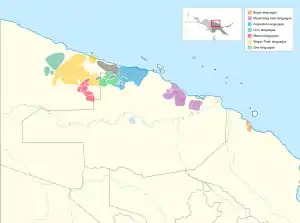Arapesh languages
The Arapesh languages are several closely related Torricelli languages of the 32,000 Arapesh people of Papua New Guinea. They are spoken in eastern Sandaun Province and northern East Sepik Province, Papua New Guinea.
| Arapesh | |
|---|---|
| Ethnicity | Arapesh people |
| Geographic distribution | eastern Sandaun Province and northern East Sepik Province, Papua New Guinea |
| Linguistic classification | Torricelli
|
| Subdivisions | |
| Glottolog | arap1279 |
 The Torricelli languages as classified by Foley (2018) | |
The Arapesh languages are among the better-studied of Papuan languages and are most distinctive in their gender systems, which contain up to thirteen genders (noun classes) with noun-phrase concordance. Mufian, for example, has 17 noun classes for count nouns plus two extra noun classes, i.e. proper names and place names.[1] (See that article for examples.)
Phonology
The most notable feature of the Arapesh phoneme inventory is the use of labialization as a contrastive device.
Pronouns
Pronouns in Arapesh and other related Torricelli languages:[2]
Kombio Mountain
ArapeshSouthern
ArapeshUrim Urat Aruop Kayik 1sg apm yek~eik aeʔ kupm ŋam am kəmex 2sg yikn ɲak~ɲek inəʔ kitn nin yi kiyox 3sg kɨl ənan~nani ənən kil kin din təno 1pl an(t) okok~kwakwi apə men poi mendi kupox
Vocabulary comparison
The following basic vocabulary words are from the Trans-New Guinea database:[3]
gloss Abu' Arapesh[4] Bukiyip[5] head bʌrʌkʰa berag hair bʌrʌkʰa ear ɛligʌ atah eye ŋʌim nabep nose mutu tooth nʌluh nau̥h̥ tongue ʌhʌkʌ jaham leg burʔah aijag louse numunʌl dog nubʌt nybat pig bul bird ʌlimil aramir egg ʌlhuʌb juhuryb blood usibɛl ausibør bone pisitʌnʌgel bøløpigør skin beni'koh jageniu̥h̥ breast numʌb tree lʌ·wʌk lawag man ʌʔlemʌn araman woman numʌto ara- matoku sun uʔwʌh aun moon 'ʌ'un aun water ʌbʌl bør fire unih nih̥ stone utʌm utom road, path iʌh name ɛigil eat 'nʌsʌh one etin two biəs bium
Grammar
Recent shifts have moved Arapesh languages from the typical Papuan SOV to a SVO order, along with a corresponding shift in adpositional order. Most modifiers usually precede the noun, though as a result of changes in word order genitives and nouns do not have a fixed order.
The language's unique gender system is largely based on the ending of the noun. There are cognate pairings of each gender for singular and plural numbers. The whole gender system, unlike most of the comparable complexity in Niger–Congo languages, is sex-based: Gender IV is for all female beings and Gender VII for male ones. Arapesh culture forbids the use of personal names, so that kinship nouns are used extensively to address even intimate relatives.
Arapesh languages also have a system of verbal nouns: there by default belong to gender VIII.
Gender agreement, along with that for person and number, occurs with all adjectives, numerals and interrogative pronouns and the subject and object of verbs. Verbs in Arapesh languages are inflected by means of prefixes. The basic template for this inflection is the order SUBJECT-MOOD-ROOT.
References
- "Some Muhiang Grammatical Notes" by J. Alungum, R. J. Conrad, and J. Lukas
- Foley, William A. (2018). "The Languages of the Sepik-Ramu Basin and Environs". In Palmer, Bill (ed.). The Languages and Linguistics of the New Guinea Area: A Comprehensive Guide. The World of Linguistics. 4. Berlin: De Gruyter Mouton. pp. 197–432. ISBN 978-3-11-028642-7.
- Greenhill, Simon (2016). "TransNewGuinea.org - database of the languages of New Guinea". Retrieved 2020-11-05.
- Summer Institute of Linguistics Language Survey of Abu, 1975.
- Laycock, Donald C. 1968. Languages of the Lumi Subdistrict (West Sepik District), New Guinea. Oceanic Linguistics, 7 (1): 36-66.
External links
- WALS: Arapesh
- Arapesh Grammar & Digital Language Archive
- "Ancient Language Lives on Thanks to UVa Linguist". 2012-04-06. Retrieved 2012-08-08.